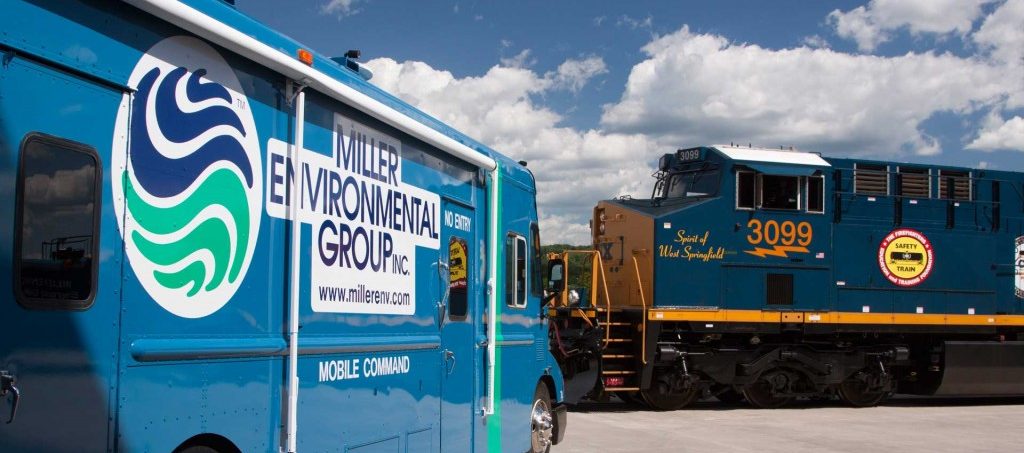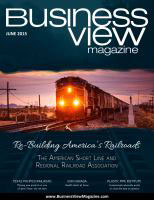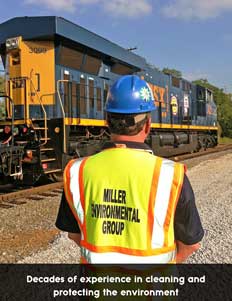Decades of experience in cleaning and protecting the environment
Thirty-nine years before the Deepwater Horizon oil spill – claimed by many to be the worst environmental disaster in U.S. history – Jim Miller Sr. was a commercial fisherman home ported out of Port Jefferson, NY. Jim was a lobsterman. His family owned a farm and he ran a commercial fishing business. On one particular day, back in 1971, there was another oil spill – this time, in his home port.
The company responsible for the oil spill hailed Jim on the way back into port to ask for assistance. Jim and his sons raced home, got whatever equipment and supplies he thought could be useful, and came back with a team, ready to help clean up the fouled waters. It was the beginning of a new business, and indeed, of a new industry.
In fact, that day in the early 1970s, was the start of Miller Environmental Group (MEG). And for the next thirty years, Jim and his team stood ready to handle whatever environmental disasters the world could throw at them. George Wallace III, MEG’s Vice President and Chief Commercial Officer, admits, “It was completely circumstance.”
In 1999 Mark Miller, the youngest of the Miller sons, purchased MEG from Jim Miller Sr., and has kept the company principles of exceptional customer service and innovation at the forefront of the business. The firm has broadly expanded its scope of services and geographic footprint under Mark’s leadership. He has overseen his firm’s involvement in such events as the 9-11 attacks on the World Trade Center, the Deepwater Horizon oil spill, Hurricane Sandy recovery efforts, and numerous high profile, high stakes projects such as chemical factory explosions, train derailments, aviation disasters, major energy infrastructure projects, and international environmental crises.
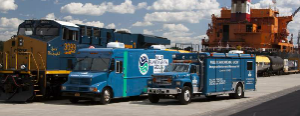 It is not, however, simply the notable environmental calamities that MEG works to ameliorate. “Our services break down to be fifty percent emergency spill response and fifty percent industrial cleaning and maintenance type work. “It happens every day,” Wallace continues. “I can look at my call log from last night and find a number of customer calls for emergency spill response support.” In 2014, MEG responded to a substantial Submarine Power Cable oil spill where the cable was damaged by a large anchor from a vessel. In this case the oil spill was but one component of a large scale marine support project. MEG provided divers and submarine excavation equipment to unearth the cable, locate the leak, and secure the leak with a clamp. “This is a specialty service that our customers have come to rely on MEG’s knowledge, experience, and specialized equipment over the history of the company.”
It is not, however, simply the notable environmental calamities that MEG works to ameliorate. “Our services break down to be fifty percent emergency spill response and fifty percent industrial cleaning and maintenance type work. “It happens every day,” Wallace continues. “I can look at my call log from last night and find a number of customer calls for emergency spill response support.” In 2014, MEG responded to a substantial Submarine Power Cable oil spill where the cable was damaged by a large anchor from a vessel. In this case the oil spill was but one component of a large scale marine support project. MEG provided divers and submarine excavation equipment to unearth the cable, locate the leak, and secure the leak with a clamp. “This is a specialty service that our customers have come to rely on MEG’s knowledge, experience, and specialized equipment over the history of the company.”
MEG also provides Environmental Remediation, Marine Services, Waste Transportation and Disposal, Restoration, Training and Compliance, and Portable Services. In addition the Greenway Environmental Management division of MEG provides geothermal and alternative energy services to commercial, municipal, and residential customers in order to help them save on their energy bills.
Recently, MEG partnered with CSX, the domestic transportation company, to carry out safety and preparedness training for First Responders. “Miller worked closely with CSX in 2014 to bring hands on training to the First Responders that serve the communities along the CSX rail,” Wallace said. Miller brings a sampling of the equipment that a response team would normally bring to an incident and then additionally works with CSX to train the First Responders on the rail cars moving through the local community.
Miller Environmental is continually updating its equipment and services, which consistently puts the company ahead of the curve. “In 2011 MEG completely turned over our fleet,” Wallace advises. “We purchased all new Kenworth equipment, that is clean-idle and clean-air certified.” The clean equipment acquisition is in response to the Environmental Protection Agency’s (EPA) diesel emission reduction standards, which go into effect in 2016 on the federal level and that many states have already adopted.
Internally, MEG has a very dynamic website, which affords existing and prospective clients the opportunity to easily review the types of equipment available to them on a moment’s notice. The company has instituted new accounting software with field automation, which, according to Wallace, will help them grow and analyze their business further. “The use of tablet devices in the field will provide more real time dispatch and coordination of our crews working hard to service our customers.” says Wallace.
While MEG is constantly evolving, there are two areas 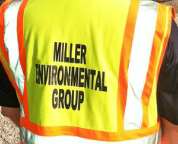 that remain constant. “We spend a lot of time taking care of our customers and training our staff.” Wallace continues, “From the top down and bottom up, people are well trained.” The training of staff is paramount to the success of a business in this field. MEG has taken this process one step further when working with railroads. “One of the things we’re doing right now with railroads, is we’re helping them with their geographic specific response planning. They have rail cars traveling designated cargo routes; we’re working with them to analyze these routes and helping them plan for potential releases and the response to a release along each route.”
that remain constant. “We spend a lot of time taking care of our customers and training our staff.” Wallace continues, “From the top down and bottom up, people are well trained.” The training of staff is paramount to the success of a business in this field. MEG has taken this process one step further when working with railroads. “One of the things we’re doing right now with railroads, is we’re helping them with their geographic specific response planning. They have rail cars traveling designated cargo routes; we’re working with them to analyze these routes and helping them plan for potential releases and the response to a release along each route.”
What this means is that MEG is not only training internally for inevitabilities, but also educating their clients to ensure that everyone is as prepared as possible. “Should something happen, they’re ready.”
With an industry that clearly isn’t slowing down, and with others in the clean-up business, how does a company like MEG remain competitive? “I would say that we remain competitive by taking very good care of our customers and employees, reinvesting in the company each year, and ensuring that we do good business. There are a handful of good providers out there.” Wallace continues, “There certainly are smaller companies that have more limited capabilities because of a big spill like Deepwater Horizon. You could drive into town and get hired on the job during the Deepwater Horizon oil spill. It takes a lot more to be in business before and after the big spill.”
“Every decision we make, we make as if we’re a very small company,” Wallace states. “However, we have a lot of depth in our personnel and equipment beyond the scope of what we need to service our day- to-day business. The additional depth that we maintain positions our company for opportunity to support ongoing projects or emergency responses at any given time.” As an example of the forward thinking and innovative spirit of MEG, it owns a patent protected technology that is US EPA Permitted at the national level to decontaminate Polychlorinated Biphenyls (PCB’s) from Natural Gas Systems and its components. “We have an ongoing series of projects with both gas transmission companies and local gas distribution companies to clean their air compressor stations, gas scrubbers, filter separators, and any pipe/fittings that test hazardous for PCB’s,” explains Wallace.
So what does the future hold for MEG? “I see growing partnerships between our customers and ourselves; more training and capability, as opposed to arbitrarily building; growing around the companies we’re supporting.”
Four decades ago, a local fisherman helped clean up an oil spill. Today, MEG is a tested leader in the day- to-day business of remediating and restoring our environment when a disaster has occurred.
AT A GLANCE
WHO: Miller Environmental Group, Inc.
WHAT: Environmental cleanup organization
WHERE: Throughout the US
WEBSITE: www.millerenv.com
